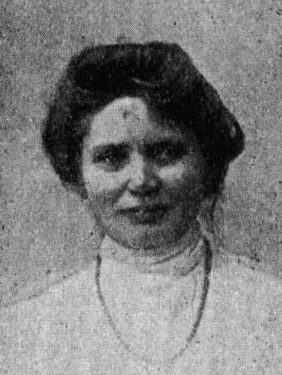Charlotte Eilersgaard facts for kids
Charlotte Juliane Sofie Eilersgaard (born Jensen) (1858–1922) was a Danish writer and editor. She wrote many short stories, plays, and novels. From the early 1900s, she became very active in the women's movement. She especially worked hard for women to get the right to vote.
Her Life Story
Charlotte Juliane Sofie Hansen was born on March 25, 1858, in Hjørring, Denmark. Her father, Lars Møller Jensen, traded cattle, and her mother was Anna Katrine Mettelmann. As a child, Charlotte loved writing poems. She filled her drawers with her own creative works.
After going to a girls' school in Hjørring, she also learned languages at home. When she was 20, she married Jacob Peter Martinus Julius Eilersgaard, who was an editor.
Her Writing and Editing Work
Charlotte Eilersgaard wrote many long stories (novels) and plays. Many of her plays were performed in Copenhagen and other big cities in Denmark. One of her most popular works was Jægermesterinden. It was first a novel in 1907. Later, it was turned into a play for the Folketeatret theatre. The story is about a young woman who helps her parents, a hunter and a housekeeper, solve their problems by getting married.
Her work as an editor started in 1898. At that time, she and her husband moved to Middelfart. There, she edited the Aarup Avis newspaper. She also joined the Red Cross. She led the local women's group for the Red Cross.
Working for Women's Rights
In 1903, Charlotte Eilersgaard became the president of the Middelfart branch of the Danish Women's Society (Dansk Kvindesamfund). Here, she strongly supported women's voting rights. This was the main goal of the organization. She was a bit worried when another group, the National Association for Women's Suffrage, started a local branch in Middelfart too.
In 1904, she went to a big meeting in Berlin. This was the International Council of Women's conference. At the conference, she gave a talk called Die Frauenbewegung in Skandinavien. This means 'The Women's Movement in Scandinavia'.
When women in Denmark finally got the right to vote in 1915, Charlotte Eilersgaard had a clear idea. Unlike another women's rights leader, Gyrithe Lemche, Charlotte believed women should join the political parties that already existed. She thought it was better than creating new parties just for women.
For the rest of her life, Charlotte Eilersgaard kept writing. She published a new play or novel almost every year. Some of her works were even translated into other languages. She passed away on May 9, 1922, in Helsingør. She was living in a retirement home called Montebello at the time. She is buried in Middelfart.


